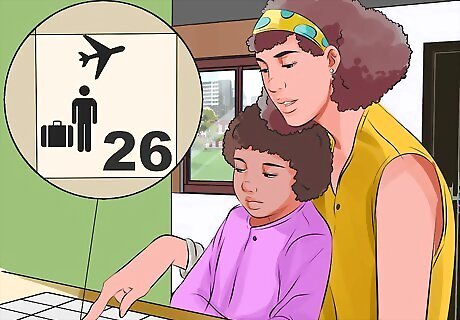
views
X
Research source
Not feeling in control of their feelings can be scary-- especially for a child who receives limited sensory input-- and having a calm and supportive parent can help calm the child. Help them understand their feelings and feel calm. Find ways to avoid tantrums by following a schedule and being sensitive to your visually-impaired child’s needs. Don’t be afraid to ask for help from other parents or a behavior therapist.
Responding in the Moment

Observe your child’s behavior. As your child gets older, you will see and observe new behaviors that were not there before. These behaviors may not fit into what you would identify as developing skills. It is important to note that all children will go through these phases, and this is a normal part of growing up. However, many of these “problem behaviors” may be unfamiliar or unexpected, and they can change quickly. As children age, they may become frustrated with situations or parental figures because of their desire to want to do things on their own. They will also begin to experience bigger and more complex emotions that can fluctuate and change quickly. Just remember that your child is learning how to communicate. It is up to you to guide them into learning more helpful, safe and appropriate response patterns. If strategies that you’ve used before are not working, call on your support team for help and advice. This could be your spouse, extended relatives, neighbors, friends, medical provider, therapist, church group members, or community parenting group. They can offer you support as you work through things with your child, but remember that you are the expert where your own child is concerned.

Identify challenging behaviors. Regardless of the behavior you may be witnessing in your child, remember that you are the expert and the positive role model and guide for your child. You will need to develop interventions that will model appropriate behavior for your child. Also, keep in mind that your child’s limited or lack of vision is not the main reason for such behaviors. Challenging behaviors (tantrums) with visually impaired or blind children are categorized and they can be identified as follows: Physical. This may include either dropping to the floor while screaming and/or crying, leaving the area, hitting, biting, scratching, pulling hair, head butting, kicking, punching, and slapping. The child may direct these behaviors toward the caregiver, other children or people, an object in the room, or the child himself. Verbal. This may include yelling, screaming, using verbally aggressive words or profanity, and speaking loudly. Emotional. This may include crying, screaming in anger, or any other emotional changes in body language or facial expressions.

Teach behavioral skills. Understand that the child who is having the “tantrum” or displaying challenging behavior has learned to do this to get what he or she wants. This behavior must have worked for the child at some point in the past for the child to continue the behavior. This means that child may not have the appropriate social skills or not know how to use them. These skills may include: Language and speech. This may include learning and accumulating appropriate vocabulary as a toddler, using single or combination of words clearly, and the ability to associate and apply concepts with language. Social. This is the ability to communicate their needs and wants both using words and using nonverbal means. They can also communicate in a way that is assertive, healthy, appropriate and respectful of others. Self- or mutual-regulation. This is the ability to play with other children and develop friendships through sharing or pretend playtime, as well as to be able to relate to others and express empathy.

Remain calm. If your child’s tantrum makes you instantly frustrated, upset, angry, or enraged, take a step back before responding. Take a few deep breaths and find your center. Manage your own emotions before stepping in to handle your toddler’s emotions. If your toddler is screaming or yelling at you, don’t yell back. This can escalate the tantrum and make both you and your child feel worse. Staying calm shows your toddler that big emotions can be dealt with and managed without escalation. If you feel too overwhelmed to handle the situation, ask another available adult to step in while you cool down.

Recognize a meltdown. A meltdown might occur if your child feels overwhelmed by their surroundings. This might mean that music is too loud, there’s indistinct chatter, or they can’t figure out where they are or what’s happening in their environment. Their sensory input may be too great for them to handle, which can lead to a meltdown. If your child’s senses are on overload, remove them and take them to a quieter, less stimulating place. Not being able to see the world around them can be scary. If your child fears noisy or echo-y places, have a plan for when you go to loud events.

Label their feelings. Get down on your child’s level by kneeling or sitting next to them. Let them know you notice how they are feeling. They need help managing their emotions, so start first by labeling the feeling. Say, “You have an angry face on, does that mean you’re feeling angry?” This shows them that you’re tuned into their feelings. You can also say, “It’s hard not to get what you want. You wanted to eat crackers, but I said, “No” and that made you upset.” Help your child to learn to label their own feelings by asking them to use their words. Blind children may rely more on verbal communication, so teach them to express themselves and how they feel.

Use a safe place to calm down. You might want to go to a quiet place to help them settle down. Continue speaking to them in a calm voice. If you’re at home, have a safe place your child can go that feels comfortable and familiar to them. Put on some gentle music or give them something soft to hold. If you are somewhere out in public, consider going outside, in a hallway or to the bathroom as a way to get away from people and loud noises. Being somewhere that’s safe can help your child feel more secure and lower their fears. Especially if they feel unsafe because they cannot see what’s going on, having a safe, familiar place can be comforting.

See acting out as expressing a need. Toddlers aren’t fully capable of expressing their wants and needs, so their frustration can express as a tantrum. Think about what event or events preceded the tantrum. Was your child trying to express or communicate something that wasn’t received? Did they feel ignored or not important? Communicating with you and participating socially are important parts of your toddler’s developing world, so think about what need their tantrum might express. A tantrum might indicate a bid for attention that was glossed over or a child who needs a nap. Use some investigative skills to see if there’s a need your child is asking you to fill. It can be as simple as giving them your attention, offering help, or feeding them a snack.

Show empathy and understanding. Visually impaired children differ from their peers and may struggle more with their emerging abilities as toddlers. They might notice that tasks are more difficult or that others are faster or get more positive praise. Your child might not know how to express that they need help or assistance or that they feel left behind. While tantrums can be frustrating to parents, have empathy for your child and the upset they feel due to their limitations. Address their concerns by saying, “Not being able to see can be scary, especially in a new place.” or, “I know it’s hard when you feel left out from other kids.” Show care and concern for your child. However, do not use this as an excuse to ignore misbehavior.

Use timeouts if your child is destructive or violent. If your child’s tantrums are dangerous, destructive, or violent, enforce a timeout. Have a timeout chair or area away from distractions and stimuli. Seat your child in timeout and give them one minute per year of their life in timeout, or wait for them to calm down. If your child screams, yells, or gets up, return them to the timeout spot and don’t engage in any arguments or pleas for attention. When the child is calm, discuss why they went to timeout, what behaviors were inappropriate, and what they can do for next time they feel upset or violent. If you’re outside the home and your child becomes violent, you can hold your child until they calm down. You may also find a quiet area to have them sit down for a timeout.
Preventing Tantrums

Get on a schedule. Predictability can be an important part of creating structure and stability for your toddler. Following a routine can help a special needs child to practice and master skills and anticipate difficult transitions, like staying with a nanny or going to bed. Have regular times to wake-up, eat, nap, play, and go to bed. Use these opportunities to increase their confidence and learning. Tantrums commonly occur around mealtimes, bedtime, when asked to start or stop an activity, or in interactions with other children. Prepare for any potential tantrums by working the schedule around preventing these events.

Introduce new experiences. Sometimes, new things can be scary, like going to the pediatrician or dentist. Prepare your toddler for these changes by announcing them in advance. For example, if your child will get an immunization, rehearse it with a medical kit the day before so that your child knows what to expect. Describe the instruments and what the expert might do. Have verbal cues to help them anticipate what will come. Say, “The dentist will call your name, and you’ll walk back into another room with them. They will ask you to open your mouth and that’s most of what you will do. They might poke some tools into your mouth to make sure everything is okay. All you have to do is listen and follow directions.”

Anticipate problems. Look out for tantrum warning signs and learn to anticipate them. If your toddler is starting to get fussy, redirect them to another activity or offer a snack. If your child is sick, tired, or hungry, avoid situations that might trigger a tantrum. For example, if your child tends to take an afternoon nap and missed their nap, avoid activities that might upset them or that may be new to them.

Prepare your child for new experiences. Let your child know if they are going to meet someone new, go to a new place, or encounter a new situation. Let them know what they can expect and how to prepare for it. Because visually-impaired children are often sensitive to loud noises or crowded places, communicate ahead of time that they will be somewhere loud. Tell them how they can navigate problems ahead of time so that they can anticipate difficulties. For example, say, “We are going to the train station today, and it will be very busy. If you have a hard time navigating with me, we can use the stroller.” Say, “Today we are going to a new playground and you will meet new friends. We can walk around the playground before you play so that you can become familiar with it.”

Give your child choices. As toddlers start to seek independence, allow them to make small choices for themselves. For example, say, “Do you want to eat grapes or carrots?” or, “Shall we read this book or that one?” Don’t overwhelm them with choices, as this might upset them. Keep them simple and let the child choose. Your toddler can feel in control by picking out which shoes to wear, what foods to eat, and what songs they can listen to. Help them feel in control of areas that are important to them.

See a counselor. Choose a therapist or counselor who specializes in working with children and families with visual impairments. Your therapist may offer suggestions in how to speak to your toddler or modify their environment. Often, child therapists use behavior therapy with young children. They may use play to teach skills or learn better communication. Your therapist may also collaborate with you on creating a behavior plan for your child so that consequences are predictable and enforced. Find a behavior therapist by calling your insurance provider or local mental health clinic. You can also get a recommendation from a physician, friend, or family member.

Ask for advice. Seek out other parents who have a visually impaired child that you can consult. Join a support group, pose a question on an online forum, or ask friends for some advice. Talk to other parents about how they’ve gotten through their toddler’s temper tantrums and how they’ve handled specific problems related to their toddler being visually impaired. While every child is different, they might have some valuable advice for you to try. Find an online support group or look for a support group for families of visually-impaired children in your community.



















Comments
0 comment